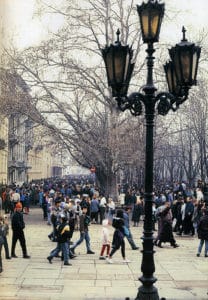By Jason Gilpin

Odessa has a severely Victorian character about it; the lampposts, sidewalks and infrastructure are something out of 1812 Hyde Park. The train station and opera house are Crimean War-era. The parks are green and manicured. This place is fancy, European, cosmopolitan and cultivated. Fantastic restaurants abound. Foreigners abound, and yet the locals do not stop to gawk at their odd tongue. Still, Odessa does have much more than a hint of Slavic culture, as the suburbs are populated with colorful Cossack cottages, the outskirts are disjointed and unplanned, and the outer skyline is guarded by wall-like concrete Soviet block apartments.
Odessa is a romantic city. Women in expensive fur coats are accompanied by well-dressed men out for a formal walk in a place that oozes a need to see and be seen. Signs advertising “marriage agencies” promised to match attractive young women with wealthy foreigners. Fashionable young couples embrace on the waterfront. They saunter across an unassuming pedestrian overpass festooned with thousands of padlocks professing love, past, present and future.
Although some might call it an industrial eyesore, I found the port area to be a vibrantly colorful picture screen displaying Ukraine’s relationship with the rest of the world; a maritime commercial traffic jam seemed to crowd the waters immediate the port, probably from Turkey, Russia, Georgia, Bulgaria, Crimea. Cargo was hurriedly off-and-on loaded from far flung places all over the world via the Bosphorus and the Dardanelles.
Many Americans are familiar with the word Odessa (although probably can’t tell you where it is), because of New York’s Brighton Beach’s Little Odessa, a district of New York founded by Ukrainian and Russian expats. In fact, America and Odessa have a lot in common. In both lands settlement was founded by diverse gigantic refugee populations.
Odessa’s early 19th century hay day was exactly that; it was founded as a free trade settlement bolstered by grain exports from the Russian Empire. German, Greek, Moldavian, Jewish, Swiss, and Polish mingled comfortably with the Ukrainian and Russian peasants, and the Nogay Tatars from the steppes. It was a city founded and managed by foreigners, existing with some autonomy in the Russian Empire. There seemed to be a very real sense of freedom here at that time.
The forefathers of the United States would have much in common with Odessa’s founder, a Frenchman by the name of Lycee Richelieu. After establishing the city and being credited with its economic success, Richelieu was appointed France’s first Prime Minister after the fall of Napoleon.
Like the Independence Hall crew, Richelieu was a man of the Enlightenment. I rather like the way Neal Ascherson, (author of the Black Sea where much of the historical info for this post comes from), put Richelieu’s character: “…energetic, austere, universal, lonely.”
The city evidently found much in common with her founder.
In my long afternoon stroll in this especially quixotic place, I felt like I did as well.
 Jason Gilpin has just returned from being an NGO Facilitator in the US Peace Corps in Sevastopol, Ukraine and is currently an MA candidate (Int’l Administration) at the University of Denver’s Korbel School of International Studies (formerly GSIS). He blogs at Gilpin on the Globe: http://jasongilpin.blogspot.com/
Jason Gilpin has just returned from being an NGO Facilitator in the US Peace Corps in Sevastopol, Ukraine and is currently an MA candidate (Int’l Administration) at the University of Denver’s Korbel School of International Studies (formerly GSIS). He blogs at Gilpin on the Globe: http://jasongilpin.blogspot.com/




hey thank you for a nice article about my native city:)
not many foreigners, which visit Odessa are interested and willing to discover the cultural heritage it possesses 🙂